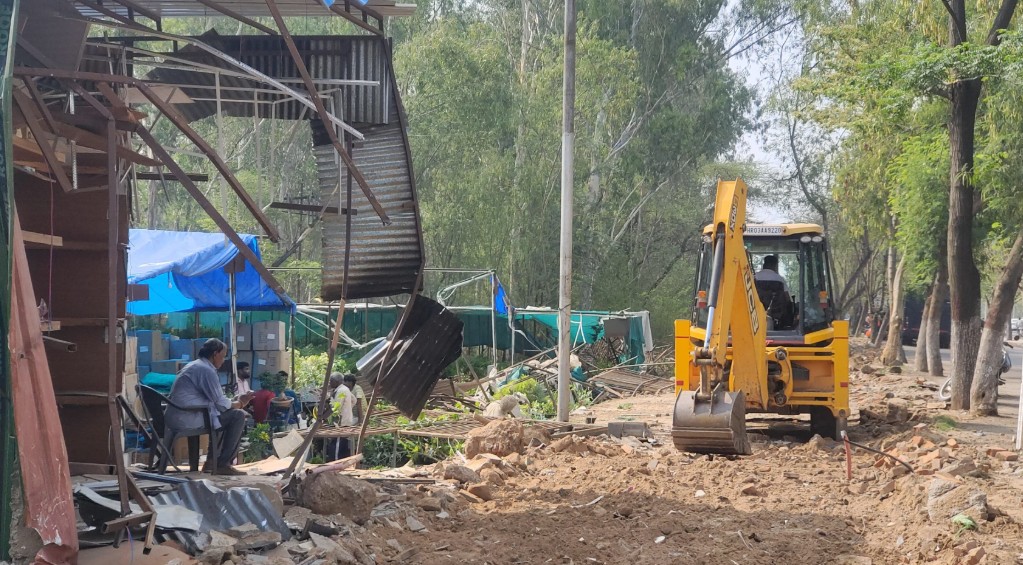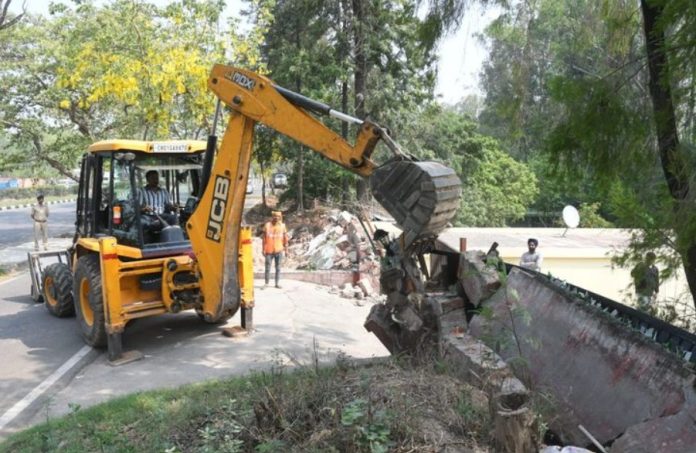In a decisive and far-reaching move that underscores its unwavering commitment to preserving the meticulously planned urban fabric and precious green belt of the Union Territory, the Chandigarh Administration has initiated a significant demolition drive, specifically targeting the unauthorized boundary walls of numerous farmhouses and nurseries. This recent enforcement action, carried out on Tuesday, May 27, 2025, on Dakshin Marg from the Hallomajra light point extending to the UT boundary with Zirakpur, represents a crucial step in reclaiming public land and upholding the sanctity of the city’s master plan and environmental regulations.
The core rationale behind this comprehensive demolition drive is rooted in the imperative to remove illegal constructions and encroachments that have steadily marred key arterial roads and vital green spaces within Chandigarh’s periphery. C.B. Ojha, Chief Engineer, Chandigarh, elucidated the immediate purpose of this specific operation, stating unequivocally that the illegal constructions were being systematically demolished to facilitate the crucial widening of a slip road and the construction of a much-anticipated 3.50-kilometer cycle track.
This infrastructural upgrade, stretching from Hallomajra Light Point to the UT boundary with Zirakpur, is designed to significantly ease traffic congestion and enhance pedestrian and cycling infrastructure, directly contributing to the city’s smart and sustainable urban development goals. However, the demolition drive extends beyond immediate roadworks; it is part of a broader, sustained campaign against unauthorized structures that have proliferated in violation of stringent building bylaws, master plan provisions, and vital environmental safeguards.

For years, the issue of illegal farmhouses, nurseries, and other commercial establishments encroaching upon public and forest land in Chandigarh’s verdant periphery has presented a persistent challenge to the Administration. Areas such as Kansal, Kishangarh, Khuda Ali Sher, Kaimbwala, and other villages bordering the Sukhna Lake catchment area and the Sukhna Wildlife Sanctuary have often been hotspots for such unauthorized development.
These properties, frequently owned by influential individuals, have historically circumvented regulations, extending their perimeters, constructing guard rooms, temporary sheds, and even permanent structures in prohibited zones. The latest drive specifically targeted boundary walls, often the first physical manifestation of encroachment, setting a clear precedent that such unauthorized expansions will no longer be tolerated. The visual impact of these demolitions, with earthmoving machines actively dismantling brick and mortar, sends a stark message across the city.
The Chandigarh Administration’s stance on these demolitions is resolute and unequivocal. It emphasizes a steadfast commitment to upholding the rule of law and protecting the invaluable public and forest land that defines Chandigarh’s unique character. Prior to the physical demolition, proper legal procedures, including the issuance of notices to the property owners, would have been followed, providing them with an opportunity to regularize or remove the illegal structures themselves. This systematic approach ensures that the demolitions are not arbitrary but are carried out with due process. The Administration is keen to convey a strong message that the era of casual encroachment and illegal construction in the Union Territory is unequivocally over. Any attempts to further exploit the city’s green belt or bypass its meticulously planned development will be met with stringent enforcement.
The stakeholders affected by such large-scale operations are diverse. The owners of these farmhouses and nurseries, many of whom have invested substantial capital, often voice their grievances, sometimes citing long-standing presence or claiming ambiguities in land demarcation. While some might pursue legal challenges, the Administration typically acts on well-established legal grounds, often bolstered by directives from the Punjab and Haryana High Court or even the Supreme Court regarding environmental protection and urban planning.
On the other hand, environmental activists and urban planning advocates vehemently support such drives. They view these demolitions as crucial for safeguarding Chandigarh’s precious green cover, its unique aesthetic, and the integrity of its original master plan, which envisioned a city with vast open spaces and controlled development. The general public’s reaction is often mixed: while there is broad support for action against illegalities and a desire to see law uniformly applied, there can also be concerns about the scale of enforcement or perceived selectiveness.
The issue of encroachment and unauthorized construction is not new to Chandigarh. Given its status as a meticulously planned city, conceived by the visionary architect Le Corbusier, the preservation of its green spaces and adherence to its master plan have always been paramount. However, rapid urbanization in its periphery and the immense pressure on land have consistently led to attempts at illegal development. Throughout its history, the Chandigarh Administration has undertaken various anti-encroachment drives, often following stringent directives from the Punjab and Haryana High Court.
The judiciary has played a crucial role in pushing the administration to protect vital ecological zones, particularly the Sukhna Lake catchment area, which is vital for the health of the iconic lake. Court orders have, at various points, banned construction in the catchment area falling under Chandigarh, Mohali, and Panchkula, leading to past demolition campaigns that targeted structures in villages like Khuda Ali Sher, Kaimbwala, and Kansal. These legal precedents provide a strong basis for the Administration’s ongoing enforcement actions.
The legal framework underpinning these demolitions is robust, drawing from various acts and regulations, including the Capital of Punjab (Development and Regulation) Act, 1952, the Punjab New Capital (Periphery) Control Act, 1952, and relevant building bylaws. Furthermore, the Forest Conservation Act, 1980, comes into play when encroachments occur on designated forest land. The Administration’s current efforts align with these established legal mandates and broader environmental conservation goals, reinforcing that no construction, however grand or seemingly temporary, can bypass the law if it violates the city’s planning principles or encroaches on protected areas.
This latest demolition drive signals that the Chandigarh Administration is not merely reacting to isolated incidents but is actively pursuing a strategy of comprehensive and sustained enforcement against illegal constructions. It sends a strong message to potential encroachers that any attempt to violate land norms, whether for commercial gain through nurseries or private use through farmhouses, will be met with firm administrative action. This proactive stance is essential for safeguarding Chandigarh’s unique architectural heritage and its identity as the “City Beautiful,” known for its verdant landscapes and planned open spaces.
The long-term implications of such sustained enforcement are manifold. It is expected to deter future encroachments, thereby protecting the city’s precious green belt, particularly around critical ecological zones like the Sukhna Wildlife Sanctuary and the various rivulets that crisscross the periphery. Enhanced connectivity and safer roadways, as a result of projects like the widening of Dakshin Marg and the construction of cycle tracks, will improve urban mobility for all residents. Furthermore, these drives reinforce the principle that urban development must occur within a legal and planned framework, preventing the chaotic and haphazard growth often seen in other rapidly urbanizing areas. The Chandigarh Administration’s continuous vigilance, coupled with the unwavering support from the judiciary, is vital in ensuring that the vision of its founders for a well-ordered, green, and beautiful city continues to be realized for generations to come, standing as a testament to disciplined urban planning amidst the pressures of growth.


